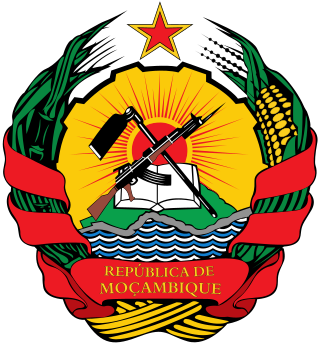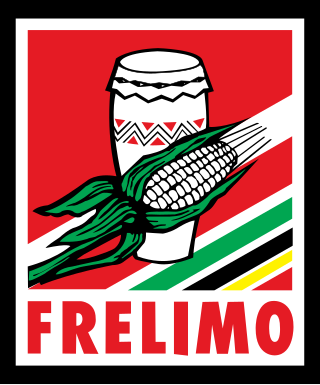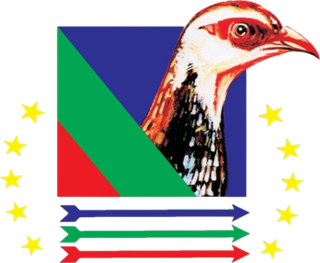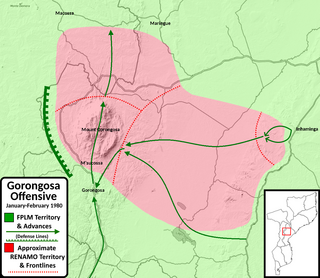Mozambique was a Portuguese colony, overseas province and later a member state of Portugal. It gained independence from Portugal in 1975.

Politics in Mozambique takes place in a framework of a semi-presidential representative democratic republic, whereby the President of Mozambique is head of state and head of government in a multi-party system. Executive power is exercised by the government. Legislative power is vested in both the government and the Assembly of the Republic.

The Zimbabwe Defence Forces (ZDF) are the military forces responsible for the defence of Zimbabwe against external threats from other countries, and also to suppress internal armed factions. It is composed of the Zimbabwe National Army (ZNA) and the Air Force of Zimbabwe (AFZ).. Since December 2017 the ZDF is headed by General Philip Valerio Sibanda.

Samora Moisés Machel was a Mozambican politician and revolutionary. A socialist in the tradition of Marxism–Leninism, he served as the first President of Mozambique from the country's independence in 1975 until his death in a plane crash in 1986.

FRELIMO is a democratic socialist political party in Mozambique. It has governed the country since its independence from Portugal in 1975.

The national flag of Mozambique is a horizontal tricolour of dark green, black, and golden-yellow with white fimbriations and a red isosceles triangle at the hoist. The triangle is charged with a five-pointed gold star in its center, above which there is a bayonet-equipped firearm crossed by a hoe, superimposed on an open book. The colours and symbols of the flag represent different aspects of the Mozambican people and their war of independence.

RENAMO is a Mozambican political party and militant group. The party was founded with the active sponsorship of the Rhodesian Central Intelligence Organisation (CIO) in May 1977 from anti-communist dissidents opposed to Mozambique's ruling FRELIMO party. RENAMO was initially led by André Matsangaissa, a former senior official in FRELIMO's armed wing, and was composed of several anti-communist dissident groups which appeared immediately prior to, and shortly following, Mozambican independence. Matsangaissa, who died in 1979, was succeeded by Afonso Dhlakama, who led the organization until he died in 2018. He was succeeded by Ossufo Momade.
Operation Dingo, or the Chimoio Massacre , was an attack by the Rhodesian Security Forces against the Zimbabwe African National Liberation Army (ZANLA) run camps at Chimoio and Tembue in Mozambique from 23 to 25 November 1977.

Afonso Marceta Macacho Dhlakama was a Mozambican politician and the leader of RENAMO, an anti-communist guerrilla movement that fought the FRELIMO government in the Mozambican Civil War before signing a peace agreement and becoming an opposition political party in the early 1990s. Dhlakama was born in Mangunde, Sofala Province.

Gorongosa National Park is at the southern end of the Great African Rift Valley in the heart of central Mozambique, Southeast Africa. The more than 4,000 square kilometres (1,500 sq mi) park comprises the valley floor and parts of surrounding plateaus. Rivers originating on nearby Mount Gorongosa water the plain.

The Zimbabwe National Army (ZNA) is the primary branch of the Zimbabwe Defence Forces responsible for land-oriented military operations. It is the largest service branch under the Zimbabwean Joint Operations Command (JOC). The modern army has its roots in the Rhodesian Army, which was raised between 1963 and 1964 after the breakup of the Federation of Rhodesia and Nyasaland. A Joint High Command created in March 1980 to oversee integration of the formerly belligerent Rhodesian Security Forces, Zimbabwe African National Liberation Army (ZANLA), and the Zimbabwe People's Revolutionary Army (ZIPRA) officially established the Zimbabwe National Army in late 1980, nearly a year after the end of the Rhodesian Bush War.

The Mozambican Civil War was a civil war fought in Mozambique from 1977 to 1992. Like many regional African conflicts during the late twentieth century, the impetus for the Mozambican Civil War included local dynamics exacerbated greatly by the polarizing effects of Cold War politics. The war was fought between Mozambique's ruling Marxist Mozambique Liberation Front (FRELIMO), the anti-communist insurgent forces of the Mozambican National Resistance (RENAMO), and a number of smaller factions such as the PRM, UNAMO, COREMO, UNIPOMO, and FUMO.
André Matsangaissa was a Mozambican anti-communist rebel and the first leader of the Rhodesian-backed Mozambican National Resistance (RENAMO).

The RENAMO insurgency was a guerrilla campaign by militants of the RENAMO party and one of its splinter factions in Mozambique. The insurgency was widely considered to be an aftershock of the Mozambican Civil War; it resulted in renewed tensions between RENAMO and Mozambique's ruling FRELIMO coalition over charges of state corruption and the disputed results of the 2014 general elections.
Dyck Advisory Group (DAG) is a private military company based in Velddrif, South Africa, founded in 2012 by Lionel Dyck, an ex-military colonel who had served in the Rhodesian Security Forces and then the Zimbabwe Defence Forces. He fought as part of the Zimbabwean intervention force that assisted the Mozambican government against RENAMO during the Mozambican Civil War. At the time, he forged good relations in the Mozambican governing party FRELIMO and with later Zimbabwean President Emmerson Mnangagwa. Following the Mozambican Civil War, he remained in the country.
The Revolutionary Party of Mozambique was an armed rebel group in northern Mozambique during the Mozambican Civil War. Founded by Amos Sumane in 1974 or 1976, the PRM was strongly opposed to Mozambique's FRELIMO government and its communist ideology. The party waged a low-level insurgency in the provinces of Zambezia, Tete and Niassa from 1977. Sumane was captured in 1980 and executed by the Mozambican government in 1981. The PRM's leadership passed to Gimo Phiri under whom the party merged with another rebel group, RENAMO, in 1982.
Colonel Flint Magama was a Zimbabwean Army officer. A political commissar for the Zimbabwe African National Union, he joined the Military Intelligence Directorate after Zimbabwean independence. Magama was involved in killings and torture during the Gukurahundi genocide and, in 1984, was responsible for the assassination of Zimbabwe African People's Union politician Njini Ntuta. In 1986 Magama was appointed commander of the Zimbabwe National Army's intervention in the Mozambican Civil War. He was killed when a helicopter he was a passenger in crashed due to engine failure during the recapture of Marromeu. Magama was posthumously awarded the country's highest military decoration for bravery, the Gold Cross of Zimbabwe.
The following is a timeline of events during the Mozambican Civil War as well as subsequent RENAMO insurgency (2013–2021).
In the Mozambican Civil War, Operation Leopard was a military operation by the FPLM in southern Manica Province which culminated in the capture of RENAMO’s stronghold in the Sitatonga 2 Mountain. Following the offensive FPLM was unable to maintain their full control over the area captured and RENAMO continued to remain active around Sitatonga 2.

The Gorongosa Offensive was a military operation by the People's Republic of Mozambique beginning in January 1980 aimed at destroying the RENAMO bases around the Gorongosa area which were increasingly threatening roads, towns, communication lines, FPLM troops and more. The Gorongosa Offensive was the first major military offensive launched by the FPLM during the war.











